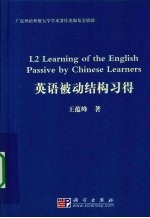
- 作 者:王蕴峰著
- 出 版 社:北京:科学出版社
- 出版年份:2009
- ISBN:9787030255877
- 标注页数:191 页
- PDF页数:209 页
请阅读订购服务说明与试读!
订购服务说明
1、本站所有的书默认都是PDF格式,该格式图书只能阅读和打印,不能再次编辑。
2、除分上下册或者多册的情况下,一般PDF页数一定要大于标注页数才建议下单购买。【本资源209 ≥191页】
图书下载及付费说明
1、所有的电子图书为PDF格式,支持电脑、手机、平板等各类电子设备阅读;可以任意拷贝文件到不同的阅读设备里进行阅读。
2、电子图书在提交订单后一般半小时内处理完成,最晚48小时内处理完成。(非工作日购买会延迟)
3、所有的电子图书都是原书直接扫描方式制作而成。
Chapter 1 Learnability and Language Learning 1
1.1 Introduction 1
1.2 The Learnability Problem of Language Acquisition 6
1.3 Learnability Considerations in Second Language Acquisition 8
1.4 Language Input 10
1.4.1 Positive Evidence 10
1.4.2 Negative Evidence 11
1.4.3 Negative Evidence in L2 Acquisition 14
1.5 Overgeneralization and Language Transfer 16
1.6 Thematic Hierarchy Condition 19
1.7 Transitivity Theory 22
1.7.1 The Transitivity Hypothesis 23
1.7.2 Morphosyntactic Reflexes of Transitivity 28
1.7.3 Criticisms of the Transitivity Hypothesis 30
1.8 Semantic Structure Theory 31
1.8.1 Conflation and Semantic Structure 32
1.8.2 Passive in English 38
1.8.3 Limitations of Pinker's Theory 42
1.9 Passivization as the Target of Research 43
1.10 Summary 45
Chapter 2 English Passivization 49
2.1 Introduction 49
2.2 Characteristics of Passive Constructions 50
2.3 Transitivity and the Passive 52
2.4 The Active-Passive Alternation 54
2.4.1 Predication Effect 55
2.4.2 Agency Effect 58
2.5 Object Affected Condition 62
2.6 English Passivizable Verbs 65
2.6.1 Canonical Action Verbs 66
2.6.2 Nonactional Verbs 68
2.6.3 Psych Verbs 70
2.7 English Non-Passivizable Verbs 77
2.8 Summary 80
Chapter 3 Crosslinguistic Variation and Language Transfer 82
3.1 Introduction 82
3.2 A Comparative Study of Chinese Passivization 83
3.2.1 The Bei Passive 84
3.2.2 The Notional Passive 88
3.2.3 Argument Animacy and Verb Transitivity 93
3.2.4 The Role of Animacy and Its Effect on Passivization 95
3.3 Overpassivization of Unaccusative Verbs 99
3.4 Crosslinguistic Influences 104
3.5 Summary 107
Chapter 4 Testing Learners'Knowledge of the English Passive 109
4.1 Introduction 109
4.2 Study 1 110
4.2.1 Subjects 110
4.2.2 Materials 112
4.2.3 Procedure 114
4.2.4 Scoring 115
4.2.5 Results and Discussion 115
4.3 Study 2 129
4.3.1 Subjects 129
4.3.2 Materials 130
4.3.3 Procedure 131
4.3.4 Scoring 132
4.3.5 Results and Discussion 132
4.4 Study 3 143
4.4.1 Subjects 143
4.4.2 Materials 144
4.4.3 Procedure 145
4.4.4 Scoring 146
4.4.5 Results and Discussion 147
Chapter 5 General Discussion and Conclusions 149
5.1 Introduction 149
5.2 Findings on L2 Learning 149
5.3 Evidence for Learning Patterns 150
5.4 Linguistic Analysis of Overpassivization of Unaccusative Verbs 151
5.5 L2 Acquisition of Argument Structure Alternations 153
5.6 Future Research 157
5.7 Conclusions 158
Appendix A 159
Appendix B 167
Appendix C 170
Appendix D 173
Appendix E 177
References 179
List of Tables 111
4.1 Mean scores of participants on an independent test of English proficiency 111
4.2 Verb categories 113
4.3 Percentage of the passive structure in the production task 116
4.4 Frequency of passive and non-passive in subjects'production 118
4.5 Item type and animacy combination in Chi-square test 119
4.6 Percentages of the passives among the eight item types 120
4.7 Verb categories and animacy combination 130
4.8 Means and standard deviations for different verbs 134
4.9 Means and standard deviations for different animacy combination 136
4.10 Verb category 144
4.11 Mean and standard deviations for the active sentences 147
4.12 Mean and standard deviations for the passive sentences 147
List of Figures 121
4.1 Number of different voices of the kill verb with AA 121
4.2 Number of different voices of the kill verb with AI 122
4.3 Number of different voices of the find verb with AA 123
4.4 Number of different voices of the find verb with AI 124
4.5 Number of different voices of the amuse verb with AA 125
4.6 Number of different voices of the amuse verb with AI 125
4.7 Number of different voices of the admire verb with AA 126
4.8 Number of different voices of the admire verb with IA 127
4.9 Mean scores in the judgment task with different verbs(NS) 133
4.10 Mean scores of judgment with different animacy combination(NS) 134
4.11 Mean scores in the judgment task with different verbs(S1) 136
4.12 Mean scores of judgment with different animacy combination(S1) 136
4.13 Mean scores in the judgment task with different verbs(S3) 137
4.14 Mean scores of judgment with different animacy combination(S3) 138
4.15 Mean scores in the judgment task with different verbs(U1) 138
4.16 Mean scores of judgment with different animacy combination(U1) 139
4.17 Mean scores in the judgment task with different verbs(U3) 139
4.18 Mean scores of judgment with different animacy combination(U3) 140
4.19 Comparisons of mean scores among five groups(different verbs) 140
4.20 Comparisons of mean scores(different animacy combination) 141
4.21 Comparisons of mean scores with different verbs(AA) 141
4.22 Comparisons of mean scores with different verbs(AI) 142
4.23 Comparisons of mean scores with different verbs(IA) 142
